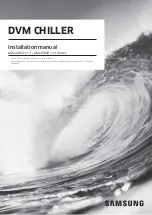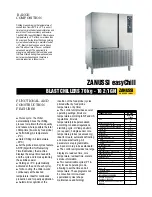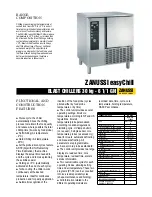
120
RTAA-SVX01A-EN
Maintenance
Chemically Cleaning The Evaporator
The chilled water system is a closed-loop and therefore should not
accumulate scale or sludge. If the chiller becomes fouled, first attempt to
dislodge the material by backflushing the system. If unsuccessful after
several attempts, chemically clean the evaporator.
CAUTION
Equipment Damage!
Do not use an acid type cleaning agent that will damage steel,
galvanized steel, polypropylene, or internal copper components.
With this information, water treatment firms will be able to recommend a
suitable chemical for use in this system.
A typical configuration for chemical cleaning is shown in
Figure 38
. The
supplier of the cleaning chemicals must provide or approve:
All of the materials used in this configuration
The amount of chemicals used
Insure that the apex of the line above the sightglass is as high as
possible, to eliminate liquid traps which can give erroneous readings.
Water Treatment
The use of untreated or improperly treated water in the unit may result in the
formation of scale, algae, or slime. It may also cause erosion or corrosion. It is
recommended that a qualified water treatment specialist provide recommen-
dations for proper water treatment.
CAUTION
Proper Water Treatment!
The use of untreated or improperly treated water in a RTAA may
result in scaling, erosion, corrosion, algae or slime. It is
recommended that the services of a qualified water treatment
specialist be engaged to determine what water treatment, if any,
is required. Trane assumes no responsibility for equipment
failures which result from untreated or improperly treated water,
or saline or brackish water.
Oil Separator Level Check
Follow the steps listed below and refer to the notes listed in
Figure 39
.
1.
Turn off the unit.
2.
Attach the hoses and sight glass to the oil separator charging Schrader
valve and the compressor discharge service valve, as shown in
Figure 39
.
Remove non-condensibles.
3.
After the unit has been off for 10 minutes, move the sight glass up and
down until the level can be seen.
Summary of Contents for RTAA-100
Page 110: ...110 RTAA SVX01A EN Start Up Procedures Figure 37 Unit Sequence of Operation...
Page 143: ...RTAA SVX01A EN 143 Pump Package Figure 47 Pump Package Piping Schematic...
Page 144: ...144 RTAA SVX01A EN Pump Package...
Page 146: ...146 RTAA SVX01A EN 3327...
Page 147: ...RTAA SVX01A EN 147...
Page 148: ...148 RTAA SVX01A EN 3328...
Page 149: ...RTAA SVX01A EN 149...
Page 150: ...150 RTAA SVX01A EN 6516...
Page 151: ...RTAA SVX01A EN 151...
Page 152: ...152 RTAA SVX01A EN 3329...
Page 153: ...RTAA SVX01A EN 153...
Page 154: ...154 RTAA SVX01A EN 6472...
Page 155: ...RTAA SVX01A EN 155...
Page 156: ...RTAA SVX01A EN 156 3330...
Page 157: ...157 RTAA SVX01A EN...
Page 158: ...158 RTAA SVX01A EN 6046...
Page 159: ...RTAA SVX01A EN 159...
Page 160: ...160 RTAA SVX01A EN 3331...
Page 161: ...RTAA SVX01A EN 161...
Page 162: ...162 RTAA SVX01A EN 6519...
Page 163: ...RTAA SVX01A EN 163...
Page 164: ...164 RTAA SVX01A EN 6047...
Page 165: ...RTAA SVX01A EN 165...
Page 166: ...166 RTAA SVX01A EN 3325...
Page 167: ...RTAA SVX01A EN 167...
Page 168: ...168 RTAA SVX01A EN 6048...
Page 169: ...RTAA SVX01A EN 169...
Page 172: ...172 RTAA SVX01A EN 3326...
Page 173: ...RTAA SVX01A EN 173...
Page 174: ...174 RTAA SVX01A EN 6049...
Page 175: ...RTAA SVX01A EN 175...
Page 176: ...176 RTAA SVX01A EN 6463...
Page 177: ......
















































